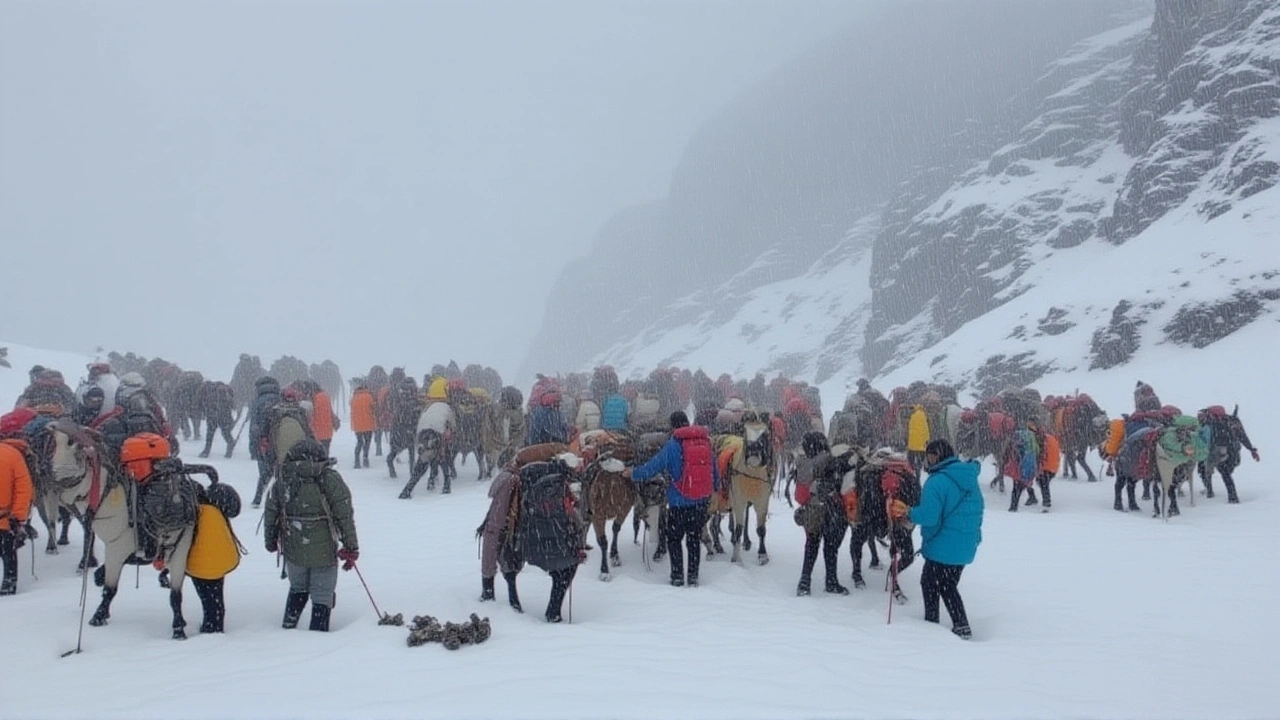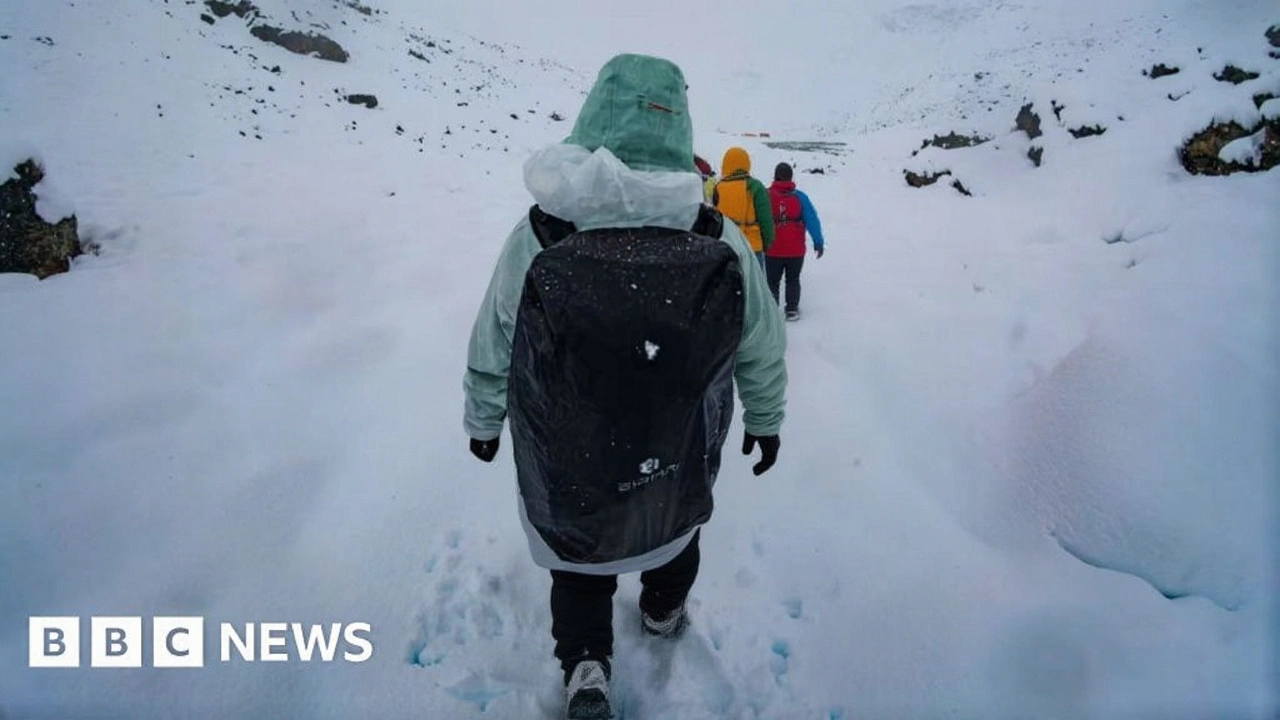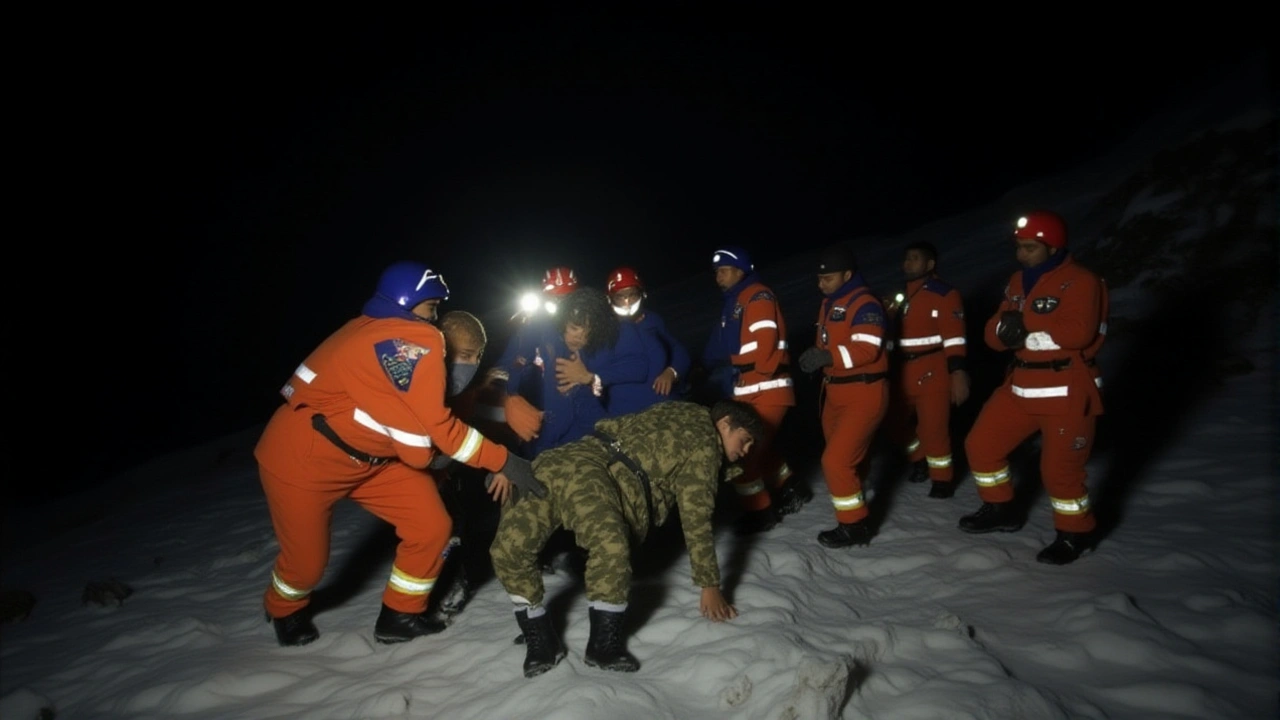When Zhang Wei, spokesperson for China Tibet Mountaineering Association announced on Oct 6, 2025 that a sudden blizzard had stranded hundreds on Mount Everest, the world’s tallest peak, rescue crews rushed in as the storm ripped across the Himalayas. Tibetan authorities later confirmed that 350 people had been evacuated, yet about 200 hikers remained trapped above 8,000 metres while torrential rains battered Nepal, Bhutan and India’s northeastern states, killing at least 60.
Background: Everest climbing season and weather norms
Traditionally, early October marks the tail end of the “post‑monsoon” climbing window, when temperatures on Everest hover around a relatively mild -5 °C to 0 °C and winds settle below 40 km/h. That stability lured an unusually large group of trekkers and climbers—estimates put the total at roughly 1,000 souls—who had set up base‑camps in the Khumbu and the Tibetan side.
Experts from the International Federation of Mountain Guides (IFMG) have warned that climate‑change‑induced variability makes even “quiet” seasons unpredictable. "We've seen a 30 % increase in extreme wind events over the past decade," said Maria Lobsang, a senior guide with the IFMG, during a briefing on Oct 7.
The blizzard and its immediate impact
The freak system, identified by the World Meteorological Organization as "Storm Omega," slammed the region with 150 mm of snow in a six‑hour window and wind gusts touching 80 km/h on the summit ridge. Snow depth at Camp III measured 1.4 m, burying tents and rendering ropes nearly invisible.
Simultaneously, the storm dumped over 200 mm of rain across Kathmandu Valley, the capital of Nepal, triggering flash floods that surged into the Bagmati River. In Bhutan, the Moeng River overflowed, destroying three villages along its banks.
According to early satellite imagery, more than 12 km of roads in the Indian state of Arunachal Pradesh were washed out, cutting off supply routes to remote border towns.
Rescue efforts on the mountain
By the evening of Oct 6, the China Tibet Mountaineering Association mobilised four helicopter units, two high‑altitude rescue teams from the People's Liberation Army, and a fleet of yak‑carried medics. The operation faced a brutal combination of low visibility, avalanche risk, and thin air.
"Every minute we lose altitude, the window for safe evacuation shrinks drastically," explained Lt. General Chen Guo, commander of the rescue task force, in a live‑feed interview on Oct 7.
Between Oct 6 and Oct 8, 350 climbers and trekkers were flown to safety from Camp II and Camp III. However, 200 remain at Camp IV and above, huddled in bivouac tents. Portable generators are providing heat, but supplies of food and oxygen are running low.

Floods, landslides and regional devastation
Beyond the summit, the storm’s rain unleashed a cascade of secondary disasters. In Nepal’s Sindhupalchok district, a massive landslide buried the village of Gaurikund, leaving at least 12 confirmed dead and dozens more missing. Rescue teams there are using rope‑teams and drones to locate survivors.
Overall death toll from the combined floods and landslides stands at 60, with 140 injured. Over 4,000 homes have been either damaged or completely washed away across the three countries.
Local governments in Nepal and Bhutan have declared states of emergency. The Nepal Ministry of Home Affairs announced a $12 million emergency fund on Oct 8, while Bhutan’s Royal Disaster Management Authority is coordinating with India for cross‑border relief.
Responses from governments and NGOs
International aid is flowing in. The United Nations Office for the Coordination of Humanitarian Affairs (OCHA) has dispatched a rapid‑response team to the region. NGOs such as the Red Cross and Médecins Sans Frontières have set up field hospitals in Pokhara and Thimphu.
“We’re seeing the full spectrum of climate‑related risk,” said Dr. Anil Sharma, senior analyst at the World Bank’s Climate Resilience Programme. "From mountain rescue to flood relief, the capacity gaps are stark. This event will likely reshape how the Himalayas are managed in the coming decade."
China’s State Council issued a statement pledging additional helicopter assets and urging the Tibetan government to prioritize the safety of all foreign tourists still on the mountain.

What lies ahead: future safety measures
Officials are now debating stricter quota limits for Everest permits during the post‑monsoon period, alongside mandatory high‑altitude weather‑alert training for all guides. The CTMA has hinted at a new real‑time satellite monitoring system to predict abrupt weather shifts.
If the remaining 200 hikers cannot be evacuated by Oct 10, the risk of hypothermia and altitude‑related illness could climb dramatically, according to medical officer Dr. Lhamo Tsering of the Tibetan Health Bureau.
- Key facts:
- Blizzard struck on Oct 6, 2025, dumping 150 mm of snow.
- 350 rescued; ~200 still stranded above 8,000 m.
- Floods and landslides killed at least 60 across Nepal, Bhutan, India.
- Rescue effort involves CTMA, PLA helicopter units, IFMG guides.
Frequently Asked Questions
How many people are still trapped on Mount Everest?
As of the latest update on Oct 9, about 200 hikers remain stranded above Camp IV, awaiting favorable weather for evacuation.
What caused the sudden blizzard on Everest?
Meteorologists label the event "Storm Omega," a rare low‑pressure system that migrated from the Bay of Bengal, bringing heavy snowfall and gale‑force winds to high altitudes while unleashing torrential rain at lower elevations.
Which countries are dealing with flood damage?
The worst flooding has hit Nepal, Bhutan, and the northeastern Indian states of Arunachal Pradesh and Assam, where rivers have overflowed and landslides have blocked key highways.
What are authorities doing to prevent a repeat?
The China Tibet Mountaineering Association plans to install an advanced satellite‑based weather‑alert network and to tighten Everest permit quotas for the post‑monsoon season, while Nepal’s Ministry of Home Affairs is revising disaster‑response protocols for mountain regions.
How can travelers help the rescue effort?
Donations to reputable NGOs such as the Red Cross and Médecins Sans Frontières are channelled to field hospitals and supply drops. Travelers are also urged to avoid non‑essential trekking in the affected zones until official clearance is granted.

Fabian Rademacher
October 7, 2025 AT 03:40They don't want you to know that Storm Omega was a controlled experiment, a test of new weather‑weapon tech hidden behind the "natural disaster" label. The rescue helicopters were suddenly grounded, which matches the pattern of governments pulling the plug when the truth gets too close. Look at the timing: the blizzard hit right after a secret summit on climate manipulation in Beijing. It's no coincidence that the same troops now claim they're there to "save lives" while their communications are jammed. Wake up, the Himalayas are being used as a playground for geopolitical power plays.
Terrell Mack
October 16, 2025 AT 20:51Whoa, that’s a heavy take, but the real heroes are the ground crews and yak medics who keep the frostbite at bay. Even in a storm, community spirit shines brighter than any conspiracy theory. Focus on the teamwork and the lives saved, because those are the stories worth sharing.
Dawn Waller
October 26, 2025 AT 13:03Oh look, another "natural" disaster-how original!!! 150mm of snow?? Yeah, right, Mother Nature must've taken a coffee break and tripped over a snowcloud. *eyeroll*
Grace Melville
November 5, 2025 AT 06:15Stay safe folks, the rescue ops are doing their best 😊
Ashlynn Barbery
November 14, 2025 AT 23:26It is commendable that the China Tibet Mountaineering Association has mobilised multiple helicopter units and high‑altitude teams to address this crisis. The collaborative effort between military and civilian experts demonstrates a robust response framework. Nevertheless, the incident underscores the need for stricter permit regulations and advanced forecasting capabilities. Implementing real‑time satellite monitoring could mitigate future occurrences. I hope that the lessons learned will inform policy decisions across the region.
Mike Laidman
November 24, 2025 AT 16:38While the statement sounds impressive the actual impact remains limited many climbers were already prepared for bad weather and the rescue logistics were hampered by the altitude
Mark Langdon
December 4, 2025 AT 09:50I feel for everyone stuck up there and for the families watching anxiously from home. The combination of blizzard and floods is a nightmare scenario, and the sheer bravery of those on the mountain is awe‑inspiring. Let’s keep sending thoughts and support to the rescuers on the ground.
Ciara Russell-Baker
December 14, 2025 AT 03:01Seriously? people still think climbing Everest is a vacation. They ignore the real risks and leave the locals to pick up the mess.
Aaron Samarita
December 23, 2025 AT 20:13The media hype around this disaster is nothing more than a ratings grab. Every article repeats the same grim statistics without acknowledging the underlying mismanagement. Helicopter crews were delayed because of bureaucratic red tape, and the permits were handed out too liberally. This is a textbook case of how profit motives override safety protocols.